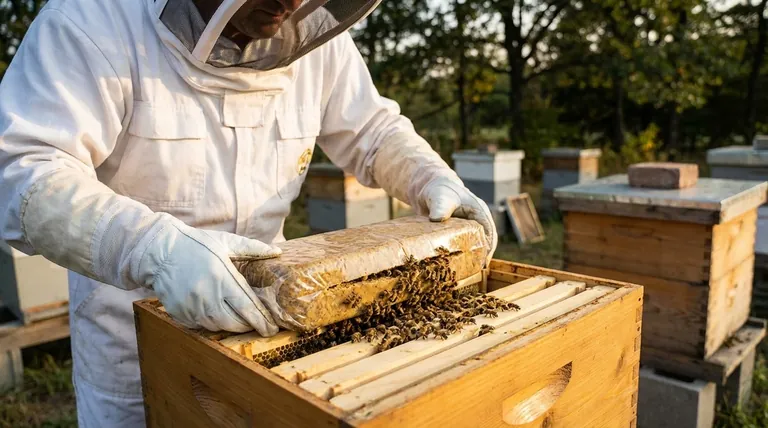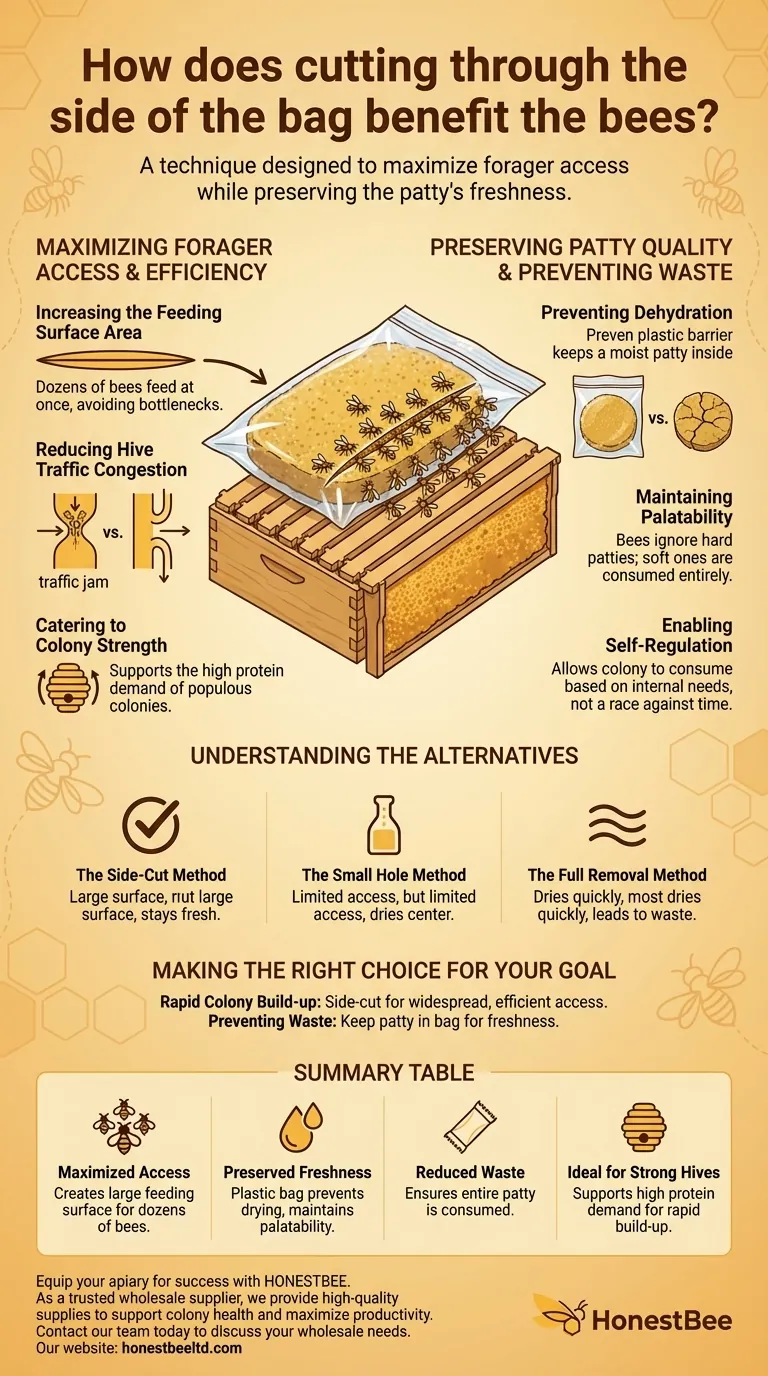Cutting the side of a pollen patty bag is a technique designed to maximize forager access while preserving the patty's freshness. This method creates a large surface area, allowing many bees to feed simultaneously, while the remaining plastic wrap prevents the substitute from drying out and becoming unpalatable.
This technique transforms a simple pollen patty from a static food source into a dynamic feeding station. It maximizes bee access while preserving the patty's quality, ensuring the colony can efficiently draw the resources it needs, when it needs them.

Maximizing Forager Access and Efficiency
The primary goal of supplemental feeding is to deliver nutrition to the colony as effectively as possible. The opening method directly impacts this efficiency.
Increasing the Feeding Surface Area
A long slit down the side of the bag creates a significantly larger feeding area compared to a small hole in the center. This linear opening allows dozens, or even hundreds, of bees to feed at once.
A small hole, by contrast, creates a natural bottleneck, limiting how many foragers can access the food at any given time.
Reducing Hive Traffic Congestion
With a larger access point, bees can easily land, collect food, and move on. This reduces the "traffic jam" effect that can occur around a small opening, leading to a more orderly and efficient collection process for the entire colony.
Catering to Colony Strength
This method is particularly beneficial for strong, populous hives. A large colony has a massive and immediate demand for protein, and a wide feeding lane ensures the patty can be consumed at a rate that matches their needs.
Preserving Patty Quality and Preventing Waste
Wasted feed is wasted investment. Protecting the pollen substitute from the elements is just as important as providing access to it.
Preventing Dehydration
Pollen patties are formulated with a specific moisture content to be attractive and digestible for bees. When exposed to the air inside a hive, they can dry out and harden quickly.
The plastic bag acts as a crucial moisture barrier. It keeps the uneaten portion of the patty soft and pliable, ensuring it remains a viable food source for days or weeks.
Maintaining Palatability
Bees will often ignore a patty that has become hard and crusty. By keeping it soft, you ensure the colony will continue to consume it until it is gone, dramatically reducing waste.
Enabling Self-Regulation
The references note that this method allows bees to "take what they want when they want it." A protected patty that stays fresh allows the colony to consume it based on its internal needs, rather than being forced into a race against dehydration.
Understanding the Alternatives
To fully appreciate the side-cut method, it's helpful to compare it to other common practices.
The Small Hole Method
Cutting a small hole or "X" in the center is a common alternative. While simple, it concentrates all feeding activity in one spot, which can lead to the patty drying out from the center and creating the traffic congestion mentioned earlier.
The Full Removal Method
Some beekeepers remove the patty from the bag entirely and place it directly on the top bars. This provides maximum initial access but also causes the patty to dry out extremely quickly, often leading to significant waste if the colony cannot consume it within a day or two.
Making the Right Choice for Your Goal
Your feeding strategy should align with your specific beekeeping objectives.
- If your primary focus is rapid colony build-up: The side-cut method provides the widespread, efficient access needed to fuel population growth in strong hives.
- If your primary focus is preventing waste: Keeping the patty in the bag is critical, and the side cut ensures the food remains soft and palatable until it is fully consumed.
- If you are feeding a small nucleus colony: While a side cut is still effective, you might consider making a shorter slit to moderate consumption and prevent the small colony from storing too much, too quickly.
Ultimately, proper feeding technique is about enhancing your bees' natural efficiency.
Summary Table:
| Benefit | Key Takeaway |
|---|---|
| Maximized Access | Creates a large feeding surface for dozens of bees at once, reducing traffic jams. |
| Preserved Freshness | The plastic bag prevents the patty from drying out, maintaining palatability. |
| Reduced Waste | Ensures the colony consumes the entire patty, providing efficient nutrition. |
| Ideal for Strong Hives | Supports the high protein demand of populous colonies for rapid build-up. |
Equip your apiary for success with HONESTBEE. Proper feeding techniques are just one part of a thriving operation. As a trusted wholesale supplier, HONESTBEE provides commercial apiaries and beekeeping equipment distributors with the high-quality supplies needed to support colony health and maximize productivity. Let us help you streamline your operations. Contact our team today to discuss your wholesale needs.
Visual Guide

Related Products
- Cotton Beekeeping Suit and Round Hat with Veil Bee Keeper Protective Gear
- Wooden Bee Brush with Triple Row Artificial Fiber for Beekeeping
- Yellow Plastic Bucket Pail Perch for Beekeeping
- Beekeeper Cowboy Hat and Veil for Beekeeping
- Professional Beekeeping Suit for Kids and Girls Childrens Bee Keeper Suit
People Also Ask
- Do beekeeping suits completely prevent stings? Maximize Your Apiary Safety with the Right Gear
- How should a beekeeping suit be hung to maintain its shape? Protect Your Investment with Proper Storage
- What are bee suits made of? Choosing the Right Material for Maximum Protection & Comfort
- What are the benefits of a fully ventilated beekeeping suit? Stay Cool and Protected in Hot Climates
- What is recommended for beginners in beekeeping regarding protective clothing? A Complete Safety Guide for New Beekeepers



















